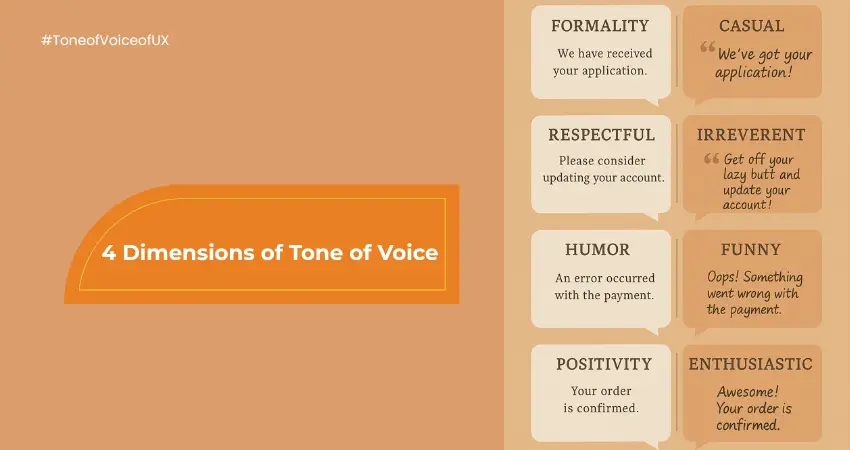Tone of voice in UX writing is more than just personality—it’s a powerful UX design principle that influences user trust, clarity, and connection. And in an online environment where users are constantly scanning and judging with limited attention spans, tone becomes the invisible bridge between design and human experience.
Table of Contents
ToggleWhether you’re writing a 404 error message, onboarding flow, or chatbot script, your tone of voice determines how the message lands—emotionally and cognitively.
This article breaks down the four essential tone of voice dimensions—developed through usability research—and shows how content writers and UX professionals can use them to craft accessible, consistent, and compelling microcopy.

Why Tone of Voice in UX Writing Isn’t Optional Anymore
Tone of voice is often dismissed as something you sprinkle at the end of the content process. That’s a mistake. Here’s why it deserves a front-row seat in every UX writing strategy:
- It builds trust. A consistent and relatable tone builds credibility and emotional comfort.
- It reduces cognitive load. Familiar and human-centred language is easier to process, especially in high-stress moments like error handling or payments.
- It reflects brand integrity. Your product’s tone should echo your values. If you’re a brand that promotes simplicity and empowerment, your copy should too.
- It shapes user behavior. Tone can nudge users toward taking action or provide the reassurance they need to continue a task.
Tone isn’t an overlay—it’s part of the UX architecture.
The 4 Dimensions of Tone of Voice (and How to Use Them)
The tone of your writing can be broken down into four sliders or spectrums. These allow teams to visualise, define, and apply voice in a more systemised way.
1. Formal vs Casual
Formality sets the tone for how professional or conversational your writing feels.
- A formal tone is structured, respectful, and restrained. It minimises contractions and slang and is best suited for sensitive, legal, financial, or high-stakes content.
- A casual tone mirrors everyday speech. It uses contractions and informal phrases. This style humanises the interface and makes it approachable.
Deeper Insight: A formal tone may signal authority but can also create distance. A casual tone feels warm but may lose precision. Balance based on the user journey stage.
Tip for writers: If you’re writing across multiple touchpoints (e.g., FAQs, landing pages, chat support), define a tone range rather than a single point.
Formal: “Your credentials have been verified.”
Casual: “All set! You’re good to go.”
2. Funny vs Serious
Humour in UX writing is powerful—but it’s not always welcome.
- A humorous tone introduces playfulness and charm. It’s ideal for light-hearted products, creative industries, or gamified user experiences.
- A serious tone is neutral, direct, and no-nonsense. It’s crucial during tasks that involve user stress, confusion, or critical data.
Deeper Insight: Humour is cultural, contextual, and highly subjective. What works in a Gen Z fintech app may fall flat in an enterprise SaaS dashboard.
Tip for writers: Always user-test humour. One misplaced joke can erode brand trust more than a typo.
Funny: “Oops! We messed up. We’re fixing it faster than you can say ‘debug’.”
Serious: “An unexpected error occurred. Please try again.”
3. Respectful vs Irreverent
This dimension speaks to how seriously the brand takes the user’s emotions, expectations, and boundaries.
- A respectful tone communicates empathy, support, and user-centric thinking. It avoids assumptions, sarcasm, and flippant responses.
- An irreverent tone is bold, edgy, and sometimes provocative. It deliberately challenges norms to stand out and appeal to a specific, loyal user base.
Deeper Insight: This spectrum often aligns with your brand’s broader values. Are you inclusive and careful, or do you want to push boundaries and be noticed?
Tip for writers: Irreverence is not the absence of respect—it’s a calculated tone strategy. If you’re targeting niche audiences, irreverence can be magnetic.
Respectful: “Would you like to turn on reminders?”
Irreverent: “Want us to nag you with helpful reminders? You know you love it.”
4. Enthusiastic vs Matter-of-Fact
This spectrum deals with energy—how much enthusiasm or emotional weight your writing carries.
- Enthusiastic writing radiates positivity and excitement. Use it for moments of achievement, onboarding, or promotions.
- A matter-of-fact tone is neutral and direct. It’s suitable for documentation, transactions, and backend processes.
- Deeper Insight: High enthusiasm during error messages can feel tone-deaf. Similarly, a flat tone during user success moments may undercut momentum.
Tip for writers: Treat tone like a thermostat. Dial it up during emotionally positive touchpoints; lower it during serious or instructional content.
Enthusiastic: “Hooray! You’ve unlocked your next milestone!”
Neutral: “Your progress has been updated.”
How to Build a Scalable Tone of Voice Strategy
Too often, tone is inconsistent because teams write in silos. Here’s how to build a shared framework:
- Create a Tone of Voice Grid
Plot your product’s default tone across the four dimensions. Use examples of what to say and what not to say to build clarity. - Map Tone to Journey Stages
Define how tone shifts across onboarding, support, transactions, empty states, and celebrations. For example:
- Onboarding = Casual + Enthusiastic
- Error message = Formal + Serious
- CTA = Casual + Confident
- Use Voice Principles to Train Teams
Go beyond do’s and don’ts. Create a tone principle like “We speak like a friendly expert—approachable but precise.” Let this drive how content is shaped. - Test, Analyse, Iterate
Use tone testing frameworks like pairwise tone comparison, heatmaps, and task completion rates. UX writing is UX. Track how tone affects performance metrics.
To Sum Up
Tone of voice in UX writing is not the finishing touch—it’s part of the interface. It guides, reassures, persuades, and sometimes even entertains.
By understanding and applying the four tone dimensions—formality, humour, respectfulness, and enthusiasm—you build more human-centred, credible, and persuasive experiences. In an era where users are bombarded by apps, notifications, and messages, tone becomes your differentiator.
